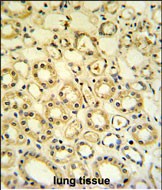H6PD Antibody (C-term)
Affinity Purified Rabbit Polyclonal Antibody (Pab)
- SPECIFICATION
- CITATIONS: 1
- PROTOCOLS
- BACKGROUND

Application
| IHC-P, WB, E |
|---|---|
| Primary Accession | O95479 |
| Other Accession | Q8CFX1 |
| Reactivity | Human, Mouse |
| Host | Rabbit |
| Clonality | Polyclonal |
| Isotype | Rabbit IgG |
| Calculated MW | 88893 Da |
| Antigen Region | 743-769 aa |
| Gene ID | 9563 |
|---|---|
| Other Names | GDH/6PGL endoplasmic bifunctional protein, Glucose 1-dehydrogenase, Hexose-6-phosphate dehydrogenase, 6-phosphogluconolactonase, 6PGL, H6PD, GDH |
| Target/Specificity | This H6PD antibody is generated from rabbits immunized with a KLH conjugated synthetic peptide between 743-769 amino acids from the C-terminal region of human H6PD. |
| Dilution | WB~~1:1000 IHC-P~~1:50~100 |
| Format | Purified polyclonal antibody supplied in PBS with 0.09% (W/V) sodium azide. This antibody is purified through a protein A column, followed by peptide affinity purification. |
| Storage | Maintain refrigerated at 2-8°C for up to 2 weeks. For long term storage store at -20°C in small aliquots to prevent freeze-thaw cycles. |
| Precautions | H6PD Antibody (C-term) is for research use only and not for use in diagnostic or therapeutic procedures. |
| Name | H6PD (HGNC:4795) |
|---|---|
| Synonyms | GDH |
| Function | Bifunctional enzyme localized in the lumen of the endoplasmic reticulum that catalyzes the first two steps of the oxidative branch of the pentose phosphate pathway/shunt, an alternative to glycolysis and a major source of reducing power and metabolic intermediates for biosynthetic processes (By similarity). Has a hexose-6-phosphate dehydrogenase activity, with broad substrate specificity compared to glucose-6-phosphate 1-dehydrogenase/G6PD, and catalyzes the first step of the pentose phosphate pathway (PubMed:12858176, PubMed:18628520, PubMed:23132696). In addition, acts as a 6-phosphogluconolactonase and catalyzes the second step of the pentose phosphate pathway (By similarity). May have a dehydrogenase activity for alternative substrates including glucosamine 6-phosphate and glucose 6-sulfate (By similarity). The main function of this enzyme is to provide reducing equivalents such as NADPH to maintain the adequate levels of reductive cofactors in the oxidizing environment of the endoplasmic reticulum (PubMed:12858176, PubMed:18628520, PubMed:23132696). By producing NADPH that is needed by reductases of the lumen of the endoplasmic reticulum like corticosteroid 11-beta-dehydrogenase isozyme 1/HSD11B1, indirectly regulates their activity (PubMed:18628520). |
| Cellular Location | Endoplasmic reticulum lumen |
| Tissue Location | Present in most tissues examined, strongest in liver. |

Provided below are standard protocols that you may find useful for product applications.
Background
H6PD is 2 forms of glucose-6-phosphate dehydrogenase. G form is X-linked and H form, encoded by this gene, is autosomally linked. This H form shows activity with other hexose-6-phosphates, especially galactose-6-phosphate, whereas the G form is specific for glucose-6-phosphate. Both forms are present in most tissues, but H form is not found in red cells.
References
Balazs, Z., et al. Mol. Cell. Endocrinol. 301 (1-2), 117-122 (2009) Zhang, Y.L., et al. Arch. Biochem. Biophys. 483(1):45-54(2009) Uckaya, G., et al. Diabetes Res. Clin. Pract. 82 SUPPL 2, S135-S140 (2008)
If you have used an Abcepta product and would like to share how it has performed, please click on the "Submit Review" button and provide the requested information. Our staff will examine and post your review and contact you if needed.
If you have any additional inquiries please email technical services at tech@abcepta.com.















 Foundational characteristics of cancer include proliferation, angiogenesis, migration, evasion of apoptosis, and cellular immortality. Find key markers for these cellular processes and antibodies to detect them.
Foundational characteristics of cancer include proliferation, angiogenesis, migration, evasion of apoptosis, and cellular immortality. Find key markers for these cellular processes and antibodies to detect them. The SUMOplot™ Analysis Program predicts and scores sumoylation sites in your protein. SUMOylation is a post-translational modification involved in various cellular processes, such as nuclear-cytosolic transport, transcriptional regulation, apoptosis, protein stability, response to stress, and progression through the cell cycle.
The SUMOplot™ Analysis Program predicts and scores sumoylation sites in your protein. SUMOylation is a post-translational modification involved in various cellular processes, such as nuclear-cytosolic transport, transcriptional regulation, apoptosis, protein stability, response to stress, and progression through the cell cycle. The Autophagy Receptor Motif Plotter predicts and scores autophagy receptor binding sites in your protein. Identifying proteins connected to this pathway is critical to understanding the role of autophagy in physiological as well as pathological processes such as development, differentiation, neurodegenerative diseases, stress, infection, and cancer.
The Autophagy Receptor Motif Plotter predicts and scores autophagy receptor binding sites in your protein. Identifying proteins connected to this pathway is critical to understanding the role of autophagy in physiological as well as pathological processes such as development, differentiation, neurodegenerative diseases, stress, infection, and cancer.


